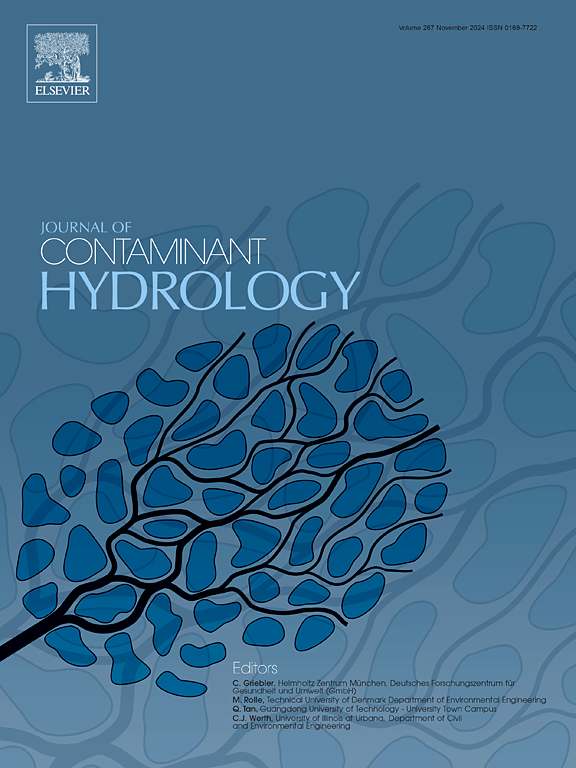河北平原浅层和深层富铁地下水的分布及成因
IF 4.4
3区 环境科学与生态学
Q2 ENVIRONMENTAL SCIENCES
引用次数: 0
摘要
富铁(0.3毫克/升)地下水在沿海平原很常见,这限制了地下水的利用,因为含铁浓度高的地下水不适合饮用、工业和农业用途。河北平原是中国沿海的大型平原,其地下水铁的分布和来源仍不清楚。本研究旨在研究河北平原各亚平原不同土地利用方式下浅层和深层地下水中铁的分布情况,探讨各亚平原富铁地下水的来源。结果表明:与山前亚平原相比,富铁地下水主要分布在中部和沿海亚平原(CSP和LSP);各次平原浅层富铁地下水的比例是深层富铁地下水的1.5 ~ 2倍。研究区农村富铁浅层地下水和林地-草原富铁浅层地下水是其他土地利用类型富铁地下水的两倍以上,而农业用地富铁深层地下水存在,其他土地不存在。在CSP中,不同土地利用类型的富铁浅层地下水所占比例约为36% ~ 43%,而在林草地和农用地中都有富铁深层地下水,但在农村地区没有。在LSP中,不同土地利用类型的富铁浅层地下水所占比例约为38% ~ 50%。厌氧NH4+氧化耦合第四纪沉积物中Fe(III)矿物的还原是CSP、LSP浅层和PSP深层富铁地下水发生的主要原因,也是PSP浅层和CSP深层富铁地下水发生的驱动机制之一。由于地下水位下降而导致的增厚渗透带(或含水层)浸出的溶解铁(III)可能是PSP浅层和CSP深层含水层富铁地下水出现的另一个驱动力。另一方面,NO3−还原伴随Fe(II)氧化和Fe(II)被氧氧化可能是抑制PSP富铁浅层地下水发生的两种机制。此外,前者还抑制了PSP富铁深层地下水的赋存。因此,未来建议通过加强外部水输入来提升地下水位,抑制PSP区富铁浅层地下水和CSP区富铁深层地下水,控制NO3−输入来抑制PSP区富铁浅层和深部地下水。建议对河北平原地下水铁进行长期监测,以加强地下水资源管理。本文章由计算机程序翻译,如有差异,请以英文原文为准。
Distribution and origins of iron-rich groundwater in shallow and deep aquifers of the Hebei plain
Fe-rich (> 0.3 mg/L) groundwater is common in coastal plains and limits the utility of groundwater, because groundwater with high concentrations of Fe is not suitable for drinking, industrial, and agricultural purposes. Nowadays, the Hebei Plain is a large scale coastal plain in China, its groundwater Fe distribution and origins still remain unclear. This study aims to investigate the distribution of Fe in shallow and deep groundwater in different land uses in various sub-plains across the Hebei Plain, and to discuss origins for Fe-rich groundwater in various sub-plains. Results showed that Fe-rich groundwater mainly occurred in both of central and littoral sub-plains (CSP and LSP) in comparison with the piedmont sub-plain (PSP). Proportions of Fe-rich groundwater in shallow aquifers were 1.5–2 times that in deep aquifers in various sub-plains. In the PSP, Fe-rich shallow groundwater in rural areas and woods-grasslands were more than double that in other land use types, while Fe-rich deep groundwater occurred in agricultural lands but absent in other lands. In the CSP, proportions of Fe-rich shallow groundwater in different land use types were about 36 %–43 %, while Fe-rich deep groundwater occurred in both of woods-grasslands and agricultural lands but absent in rural areas. In the LSP, proportions of Fe-rich shallow groundwater in different land use types were about 38 %–50 %. Anaerobic NH4+ oxidation coupled to Fe(III) minerals reduction in Quaternary sediments was responsible for the occurrence of Fe-rich groundwater in shallow aquifers of CSP and LSP and in deep aquifers of the PSP, but one of driving mechanisms for the occurrence of Fe-rich groundwater in shallow aquifers of the PSP and in deep aquifers of the CSP. Dissolved-Fe(III) from the leaching of thickened vadose zones (or aquitards) because of the failing of groundwater table was likely another driving force for the occurrence of Fe-rich groundwater in shallow aquifers of the PSP and in deep aquifers of the CSP. On the other hand, NO3− reducing accompanied with Fe(II) oxidizing and Fe(II) oxidation by oxygen were likely two mechanisms inhibiting the occurrence of Fe-rich shallow groundwater in the PSP. Besides, the former one also restrained the occurrence of Fe-rich deep groundwater in the PSP. Therefore, in the future, strengthening the input of external water for elevating the groundwater table to inhibit Fe-rich shallow groundwater in the PSP and Fe-rich deep groundwater in the CSP and controlling NO3− input for restraining Fe-rich shallow and deep groundwaters in the PSP are recommended. Besides, we also recommend long-term monitoring of groundwater Fe in the Hebei Plain to enhance the groundwater resources management.
求助全文
通过发布文献求助,成功后即可免费获取论文全文。
去求助
来源期刊

Journal of contaminant hydrology
环境科学-地球科学综合
CiteScore
6.80
自引率
2.80%
发文量
129
审稿时长
68 days
期刊介绍:
The Journal of Contaminant Hydrology is an international journal publishing scientific articles pertaining to the contamination of subsurface water resources. Emphasis is placed on investigations of the physical, chemical, and biological processes influencing the behavior and fate of organic and inorganic contaminants in the unsaturated (vadose) and saturated (groundwater) zones, as well as at groundwater-surface water interfaces. The ecological impacts of contaminants transported both from and to aquifers are of interest. Articles on contamination of surface water only, without a link to groundwater, are out of the scope. Broad latitude is allowed in identifying contaminants of interest, and include legacy and emerging pollutants, nutrients, nanoparticles, pathogenic microorganisms (e.g., bacteria, viruses, protozoa), microplastics, and various constituents associated with energy production (e.g., methane, carbon dioxide, hydrogen sulfide).
The journal''s scope embraces a wide range of topics including: experimental investigations of contaminant sorption, diffusion, transformation, volatilization and transport in the surface and subsurface; characterization of soil and aquifer properties only as they influence contaminant behavior; development and testing of mathematical models of contaminant behaviour; innovative techniques for restoration of contaminated sites; development of new tools or techniques for monitoring the extent of soil and groundwater contamination; transformation of contaminants in the hyporheic zone; effects of contaminants traversing the hyporheic zone on surface water and groundwater ecosystems; subsurface carbon sequestration and/or turnover; and migration of fluids associated with energy production into groundwater.
 求助内容:
求助内容: 应助结果提醒方式:
应助结果提醒方式:


